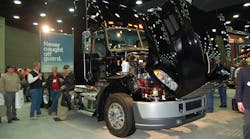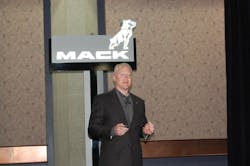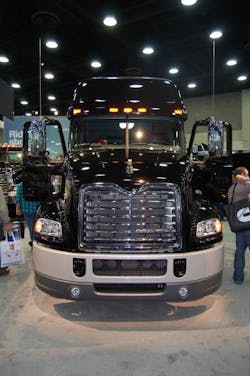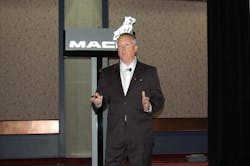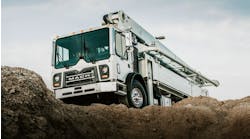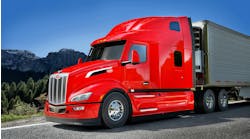LOUISVILLE, KY. Mack Trucks is offering a new “Load Logic” function for its mDrive automated manual transmission (AMT) and a 6x2 liftable pusher axle option for its Pinnacle highway tractor as part of its ongoing effort to improve component integration for its products, highway and vocational alike.
“It’s all about application excellence,” explained Stephen Roy, president of Mack Trucks North America, at a press conference here at the Mid America Trucking Show.“Our focus is on trying to optimize fuel economy and performance,” he added. “Our customers told us they need ‘no-compromises’ solutions that reduces their total cost of ownership through improved fuel efficiency and enhanced productivity.”
Roy Horton (at left), Mack’s director of product marketing, said that Load Logic integrates an advanced sensor in the rear suspension with its mDRIVE AMT that basically creates two driveline configurations within one powertrain package.
As a result, when a fully loaded trailer is detected, mDRIVE operates as a direct drive transmission and “locks out” out 12th gear for increased performance and pulling power. When an empty trailer is detected, however, the AMT switches automatically to overdrive, enabling 12th gear to lower cruise RPMs and maximize fuel efficiency.Available on Mack’s Super Econodyne-spec’d Pinnacle highway tractors in either axle back or axle forward configurations and in either 6x4 or 6x4 tandem setups, Horton said Load Logic can boost fuel economy by 2% for regional, bulk and tanker fleets.
“The best part is the transition is completely seamless to the driver,” he added.
The 6x2 with liftable pusher axle package is also being touted by Mack as a fuel saver; an axle configuration that weighs 375 to 400 lbs. less than a full 6x4 package and that’s capable of automatically determining payload via sensors again located in the rear suspension and either lifting or lowering the foremost rear axle.
Horton noted that when an empty load is detected, the axle lifts, allowing the tractor to operate as a 4x2 for less drag, better fuel efficiency and reduced tire wear, which helps lower maintenance costs. Fuel efficiency gains in “lifted-axle” mode can range from 3% to 5%, he said.
For full loads, the same axle is lowered to provide additional stability and distribution of the trailer’s weight on the fifth wheel, Horton pointed out. Additionally, to deliver optimal traction, the system’s suspension pressure and ride height are continuously monitored and adjusted to maintain a load bias toward the drive axle.
The 6x2 liftable pusher axle system does offer three driver-selectable traction control modes are available via a dash-mounted switch, he stressed:
- Enhanced Traction (ET) – Designed to boost low-speed traction for improved starts, docking and slippery road conditions
- Optimized Traction (OT) – Serving as the system’s package’s default setting, OT maximizes load to the drive axle. If wheel slip is detected, the system can temporarily increase load to the drive axle for 30 seconds to provide improved traction.
- Basic Traction (BT) – Lowers the lift axle regardless of suspension load and maintains a 50/50 load split between the lift axle and drive axle during loading or unloading, prolonged stops or areas that require 50/50 load splits between tandem axles.
While control of the lift axle is automatic based on payload during normal operation, Horton pointed out that the system does offer a manual control feature that enables a driver to raise or lower the suspension for easier landing gear retraction or trailer hook-up respectively.
Roy touched on a few other points during his talk with the media:
- Mack expects Class 8 sales in North America to reach 310,000 units this year. “It’s going to be a banner year,” Roy added, noting that if customers could hire more drivers, “we’d see a bigger number than 310,000.”
- That demand for new trucks is putting renewed pressure on Mack’s supplier base, with higher demand also being witnessed in the aftermarket.
- Mack expects sales to grow in all of its markets – vocational, regional, and long-haul truckload this year.
- Mack is extending service intervals for diesel particulate filters (DPFs) to 400,000 miles from 250,000, while diesel engine oil and filter changes on all model year 2011 and newer Mack models powered by Mack MP7, MP8 or MP10 engines are moving to 45,000 miles for long haul, 35,000 miles for regional haul and 25,000 miles for heavy haul.
- Vehicle integration, especially where the powertrain and telematics is concerned, will continue to be a top priority where Mack’s business strategy is concerned.
“By 2020, we expect [telematics] to allow us to interact more with our dealers, allow vehicles to ‘self-evaluate’ themselves for repair, make software repairs and upgrades remote via wireless transmissions, and create ‘wireless workshops’ to help further streamline the repair process,” he said.
That includes eventually offering predictive vehicle analytics to better gauge replacement times for specific components before they fail, Roy (above at right) stressed.
“It’s about getting more into big data and finding ways to use it,” he added.
